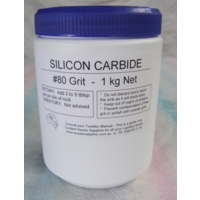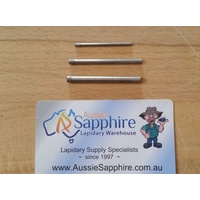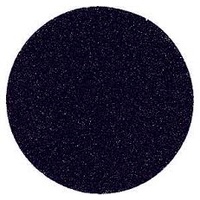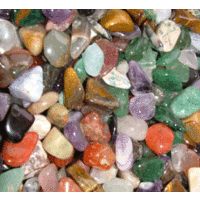Rock Tumblers are one of our biggest sellers but you may have questions - see the FAQ below and it is very likely you will find an answer.
HOW LONG DOES IT TAKE?
Time varies but when using a standard rotary (barrel) tumbler, it can take around 4 to 5 weeks of continuous operation. It is usually a 4-step process:- coarse grind, medium sand, fine sand and polish and it often takes around a week per step.
IS A TUMBLER A GOOD GIFT FOR A CHILD INTERESTED IN ROCKS?
Tumblers are a great way to get started in the lapidary hobby - the process is quite simple and although it takes some time, kids love the end product. An excellent way to learn more about our natural environment. See this blog article for more info on starter kits.
WHAT ELSE DO I NEED?
Apart from a tumbler, you will need silicon carbide grit, some suitable rock polish and a supply of rocks. The silicon carbide comes in a range of grits from coarse to fine. We sell starter kits of grit/polish - Kits 1, 2 or 3 are good for about 3 or 4 batches in a 3 pound tumbler. All components in the kit are available separately so you can restock as needed. Rocks are readily sourced from the beach, creeks/rivers or keep an eye out for suitable tumbling rock at your local gem show. Tumblers are listed with optional starter kits or as a complete package deal - just browse here for rotary tumblers of various size.
CAN I USE SAND TO GRIND ROCKS?
Some people use coarse river sand instead of silicon carbide grit to grind their rocks. This method can work after a fashion but it takes a lot longer (ie. more electricity) and you have much less control over the process. We do not recommend this method. Silicon carbide grit is relatively cheap and works much better.
HOW MUCH DOES IT COST TO RUN A TUMBLER?
The smaller Lortone tumblers only have a very small motor - they do need to run continuously but they use very little power. The 3A and 33B tumblers have a 0.33 Amp motor and the Aussie Sapphire tumbler motor is 0.3 Amps - based on 230V power supply and cost of electricity of $0.38 per kW hour, running 24 hours a day will cost around $5 per week. This is slightly less than leaving an 80 Watt incandescent light bulb on 24 hours a day.
Cost of consumables run at around $2 to $2.50 per week or less if you buy in bulk. If you collect your own rocks, this is a very cheap hobby.
ARE THEY NOISY? While vibratory tumblers can be quite noisy, the Lortone and Aussie Sapphire rotary tumblers use a solid rubber barrel which is extremely quiet. The 3A has been measured at around 55 decibels which is at the lower end of normal conversation. If you put your tumbler in the garage, you probably wont hear it running at all.
WHAT ABOUT WARRANTY?
Aussie Sapphire provides full warranty support - the warranty period on tumblers is 12 months and is handled at our NSW office/workshop. In many cases, we can remotely diagnose and provide parts - sometimes it is required to send the machine back for assessment. Warranty issues are rarely experienced - these machines are robust and reliable. We keep a full range of spares and accessories in stock.
TUMBLER MAINTENANCE - WHAT IS REQUIRED?
Rotary machines are quite simple and there is not much to go wrong. We recommend oiling the shaft bearings with a light machine oil (Singer Sewing Machine Oil or similar) - just a drop or two every 30 days of operation. At some point you will have to replace a drive belt - these only cost a few dollars and should last up to a year or more depending on usage. Our YouTube channel has some setup/maintenance videos for the main rotary tumblers which are worth looking at.
WHAT SIZE ROCKS CAN I DO?
This depends on what size tumbler you buy. A 3 pound tumbler has a barrel of about 10cm diameter and 10cm depth - you fill the barrel up to 3/4 full of rocks so your rocks need to be small enough to move freely within that barrel size. It is a good idea to have a mix of sizes to optimise the tumbling action. If your rocks are larger, then you need to move up to a larger size barrel. Dimensions of the various barrel sizes are provided in the listings and in this datasheet. A good rule of thumb is to tumble rocks that are no larger than half the diameter of the barrel along with a generous mix of smaller rocks - probably only one or two of these larger rocks - remember you need sufficient room for the rocks to tumble and grind.
SHOULD I GET A ROTARY OR VIBRATORY TUMBLER?
These are very different - if you are just starting out in rock tumbling, we generally recommend a rotary tumbler as these are easier to use for beginners and do not require as much monitoring during use. Vibratory tumblers work faster, use less consumables (grit/polish) but require checking twice daily to monitor correct slurry consistency. Rotary tumblers are slower but can be left to work without fuss between stages and are generally much quieter during operation. See this article for more info.
WHAT IS THE DIFFERENCE BETWEEN STARTER KITS?
For rotary tumblers, we recommend starter kits - 1,2 or 3. All kits contain the same 3 grades of silicon carbide grit (500 grams each of #80, #220 and #600) - you normally use about 3 to 5 tablespoons of grit per kilogram of rock. You do need to throw out the silicon carbide slurry after about a week of grinding - it is not toxic so you can dry it and throw out in the garbage.
Kit 1 has 500 grams of #14,000 (1 micron) Aluminium Oxide - a good general purpose polish suitable for rocks up to 8 hardness. Kit 1 is included in our complete tumbler kits. Kit 3 has 250 grams of Cerium Oxide polish - this one is good for rocks around hardness 6 to 7 which includes the quartz group (petrified wood, jasper, agate, amethyst, etc) or glass (natural or man-made). Kit 2 has 250 grams of Tin Oxide which is also a good general purpose polish and works well on harder rocks such as garnet or topaz as well as the softer rocks - it also contains an additional pre-polish step (500 grams #1500 Alumina) which can help if you are having trouble getting a good polish. Note that you can recycle polish slurry a few times before discarding.
All of the rotary kits should do around 3 or 4 batches in a 3 pound tumbler. They also contain a small packet of plastic pellets which are used as filler in later stages.
I WANT TO POLISH METAL INSTEAD OF ROCKS - IS THIS POSSIBLE?
Tumblers are great for metal polishing - we sell many tumblers (both rotary and vibratory) for this job. The most popular tumblers for polishing silver jewellery is the Lortone 3A or the Gyroc Model B. Larger tumblers are generally preferred for polishing brass for reloading. You need different media for working with metal - for polishing only, we recommend stainless steel shot and burnishing compound. This blog article has more information on using the 3A for polishing jewellery.
PAYMENT AND POSTAGE OPTIONS?
We post every day. Note that due to the heavy weight of these items, courier delivery is via Toll Ipec - this is a road service and may not be necessarily faster to some locations. We do require either an attended address or safe drop instruction if you choose courier delivyer. If you need your tumbler in a hurry, please check with us first but it is better to plan your purchase allowing for postage time. You can check postage cost by adding item(s) to the shopping cart and using the shipping estimator on that page - you can do this any time. We have a range of payment options to suit you - select at the checkout from PayPal, Bank Deposit or Cheque/Money Order (or email us if you want to use Visa/Mastercard).
Do you have even more questions? You are bound to find the answer in one of the following websites: http://rocktumbler.com/questions.shtml
http://www.dadsrockshop.com/faq/faq_tumblers.html#1
or view our Video Playlist with information on tumbler setup and maintenance.







